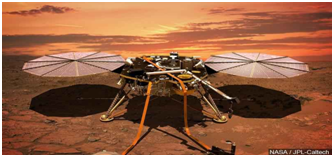

NASA’s Mars Lander InSight has recorded its first ‘Marsquake.’ It has recorded a quake of 2 or 2.5 magnitude which is hard to predict on Earth’s surface.
Context
NASA’s Mars Lander InSight has recorded its first ‘Marsquake.’ It has recorded a quake of 2 or 2.5 magnitude which is hard to predict on Earth’s surface.
About
InSight — Studying the 'Inner Space' of Mars
- InSight, short for Interior Exploration using Seismic Investigations, Geodesy and Heat Transport, is a Mars lander designed to give the Red Planet its first thorough checkup since it formed 4.5 billion years ago. It is the first outer space robotic explorer to study in-depth the "inner space" of Mars: its crust, mantle, and core.
- Studying Mars' interior structure answers key questions about the early formation of rocky planets in our inner solar system - Mercury, Venus, Earth, and Mars - more than 4 billion years ago, as well as rocky exoplanets. InSight also measures tectonic activity and meteorite impacts on Mars today.
- The lander uses cutting edge instruments, to delve deep beneath the surface and seek the fingerprints of the processes that formed the terrestrial planets. It does so by measuring the planet's "vital signs": its "pulse" (seismology), "temperature" (heat flow), and "reflexes" (precision tracking).

InSight Science Goals
- The InSight mission seeks to uncover how a rocky body forms and evolves to become a planet by investigating the interior structure and composition of Mars. The mission will also determine the rate of Martian tectonic activity and meteorite impacts.
- The InSight Mars lander has two science objectives that support the Mission's science goals:
- Formation & Evolution: Understand the formation and evolution of terrestrial planets through investigation of the interior structure and processes of Mars.
- Tectonic Activity: Determine the present level of tectonic activity and meteorite impact rate on Mars.
Why Mars?
-
- Previous missions to Mars have investigated the surface history of the Red Planet by examining features like canyons, volcanoes, rocks and soil. However, signatures of the planet's formation can only be found by sensing and studying its "vital signs" far below the surface.
- In comparison to the other terrestrial planets, Mars is neither too big nor too small. This means that it preserves the record of its formation and can give us insight into how the terrestrial planets formed. It is the perfect laboratory from which to study the formation and evolution of rocky planets. Scientists know that Mars has low levels of geological activity. But a lander like InSight can also reveal just how active Mars really is.


